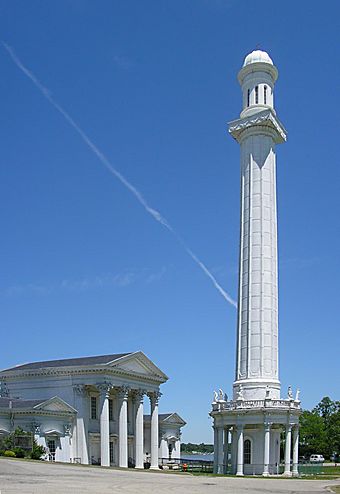Louisville Water Tower facts for kids
The Louisville Water Tower, located east of downtown Louisville, Kentucky, is a very old and beautiful water tower. It was built even before the famous Chicago Water Tower, making it the oldest fancy water tower in the world! Both the water tower and its pumping station are special because of their amazing design. They are recognized as a National Historic Landmark.
The buildings were designed to look like a Roman temple complex, even though they were for industrial use. This was similar to the Fairmount Water Works in Philadelphia.
In 2014, the Louisville WaterWorks Museum opened right there, where you can learn all about the tower and how it worked.
|
Louisville Water Company Pumping Station
|
|
 |
|
| Location | Louisville, Kentucky |
|---|---|
| Built | 1860 |
| Architect | Scowden, Theodore R. |
| Architectural style | Classical Revival |
| NRHP reference No. | 71000348 |
Quick facts for kids Significant dates |
|
| Added to NRHP | November 11, 1971 |
| Designated NHL | November 11, 1971 |
Contents
History of Louisville's Water Tower
For a long time, people in Louisville didn't have safe drinking water. This caused many to get sick. In the 1830s and 1840s, Louisville was even called "graveyard of the west." This was because dirty water from private wells caused many cases of sickness like cholera and typhoid.
It wasn't until 1854 that an English doctor named John Snow discovered the link between dirty water and these illnesses. Because of the new water system, Louisville was safe from cholera during an outbreak in 1873.
After several big fires in the 1850s, people in Louisville realized they needed a better water supply. The Kentucky Legislature decided to create the Louisville Water Company on March 6, 1854. At first, not many people wanted to invest in the company. But after a big effort to get support, voters approved buying shares in 1856 and again in 1859. This made the water company almost completely owned by the government.
Designing the Water Tower
The idea for the water tower's design came from a French architect named Claude Nicolas Ledoux. He believed that industrial buildings could also be beautiful. The city wanted the water station to be an attractive landmark. This would help people accept the new water company.
Theodore Scowden and his assistant Charles Hermany were the architects. They chose a spot just outside town, on a hill overlooking the Ohio River. This location was perfect because it was high up. It also meant that coal boats could easily deliver fuel for the station.
The main part of the tower is a tall column, 183 feet (56 meters) high. It stands on a base surrounded by a fancy Corinthian portico. Above this portico is a wooden balustrade with ten pedestals. These pedestals originally held statues made of painted cast-zinc. Even the gatehouse by the river looked like a castle!
How the Water Tower Worked
The Louisville Water Tower began working on October 16, 1860. It was not only beautiful but also very effective. In just one day, the station could produce 12 million US gallons (45,000 m³) of water. This water then traveled through 26 miles (42 km) of pipes to homes and businesses.
Changes Over Time
A powerful tornado hit on March 27, 1890, and badly damaged the Water Tower. The original tower had an iron pipe protected by wood. After the tornado, this was replaced with strong cast iron. The tornado also destroyed eight of the ten statues on the pedestals.
Soon after, a new pumping station and reservoirs were built in Crescent Hill. Because of this, the original water tower stopped pumping water in 1909. The pumping station was later updated in 2010.
In January 2013, big renovations began on the water tower property. This included adding the Louisville WaterWorks Museum. The museum officially opened on March 1, 2014.
Statues of the Water Tower
There are ten zinc statues located above the first level's balustrade. Each statue stands on a pedestal above a Corinthian column. Here are some of the statues you can see:
- An Indian hunter: He holds a tomahawk and has a dog on a leash. He might represent the element earth.
- A Danaide: She is shown emptying a large amphora (a type of jar). She represents "tasks that are never complete."
- Mercury: He wears a winged helmet.
- Winter: This statue is a woman wearing a headscarf and holding a censer with a flame.
- Hebe: She is raising a small jug above her head.
- Neptune: He holds a trident, a symbol of the sea.
- Spring: This woman holds a flower bud and a basket.
- Flora: She holds a wreath.
- Summer: This statue shields her eyes from the sun.
- Autumn: She holds a plate of harvest and has grapes in her hair.
Originally, the plans for the tower showed urns instead of statues. The first set of statues included figures like Ceres, Diana, and a girl in a bonnet.
Gallery
-
View of the tower from Duffy's Landing in Jeffersonville, Indiana
-
The Indian, Autumn, Summer, and Flora
-
Mercury, the Danaide, and the Indian






